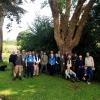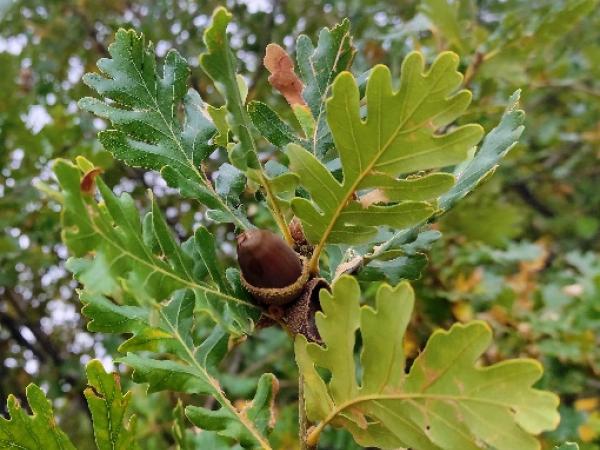Editor's Picks
Plant Focus
by Francisco Garín and José Almandoz
Jardín Botánico de Iturraran, Spain
Originally published in Oak News & Notes, Vol. 19, No. 1
The genus Quercus includes around 450 species distributed across the Temperate and Subtropical Zones of the Northern Hemisphere. Many species are practically unobtainable in commercial nurseries, and for that reason it is very difficult to create new collections that include species other than the more ordinary ones.
The best way to obtain new specimens is to travel to the countries where they grow and collect the acorns in their habitat of origin. Many collections have been formed in this way, including that of Iturraran, but today it is much harder since the Nagoya Protocol[1] has set up barriers to obtaining seed in many countries, requiring a permit that is practically impossible to obtain.

Another method is trade with other collectors who travel in search of new species. In Iturraran we have received plants from individuals such as Allen Coombes, and have exchanged material with other collections, such as the Arboretum des Pouyouleix and Arboretum Chocha. These collections face the same difficulties when attempting to obtain new accessions of the rarer species.
It is therefore necessary to look for another way for collections to grow, using existing plants to obtain vegetative material and attempt to clonally propagate it.
The system that is most used is grafting, and there are nurseries that specialize in this technique, often successfully, though not always. In these cases the problem is finding compatible rootstock. Even within species of the same section, the rootstock may exhibit delayed incompatibility. An example is Quercus rysophylla Weath. and Q. rubra L., where the latter is sometimes used as a rootstock for Q. rysophylla ‘Maya’, a cultivar with new growth of bright red leaves. After several years the graft can be lost due to delayed incompatibility. In other cases I have seen an oak in the Protobalanus section, like Q. tomentella Engelm., grafted on Q. rubra (Lobatae) or a Q. hinckleyi C.H. Mull., of shrub-like habit, grafted on Q. robur L.[2]
Another possibility is to root cuttings with the help of hormones, but commercially this method is less desirable, because a couple of years are required for the cutting to form a significant root system that will allow it to be planted in the ground. With grafts, one already has the radical system of the rootstock, which accelerates the possibility of commercialization.
We have been fortunate in being able to count on the experience of Jacky Pousse, a French specialist in plant reproduction who also travels to remote place to seek and introduce new species. When we visited his home we were able to see how, with rudimentary means, he has been able to propagate via cuttings many species of plants, including Quercus. This has encouraged us to do the same in Iturraran, and we have found that it works better with evergreen species.

We have tried the method with several species in the Iturraran collection, with varying degrees of success, between 20 and 60%, but it is always exciting when one obtains a new plant of a hard-to-find species. In this way we have obtained new specimens of the following Quercus species:
Q. insignis M. Martens & Galeotti
Q. tarahumara Spellenb., J.D. Bacon & Breedlove
Q. costaricensis Liebm.
Q. cupreata Trel. & C. H. Mull.
Q. delgadoana S. Valencia, Nixon & L.M. Kelly
Q. acatenangensis Trel.
Q. humboldtii Bonpl.
Q. obtusata Bonpl.
We have also tried Quercus from other collections, and in this way have incorporated to our collection three
species from Arboretum Chocha in Ustaritz, France:
Q. cortesii Liebm.
Q. planipocula Trel.
Q. tuberculata Liebm. (deciduous)
At the moment, we are rooting cuttings from Arboretum des Pouyouleix, including Q. miquihuanensis Nixon & C.H. Mull. and Q. pumila Walter.

The method used in Iturraran is quite simple. We wait until the new sprouts on the oaks have hardened, which at our location in northeast Spain occurs between August and October. We prefer short cuttings, which in general yield better results. For oaks with small leaves and short internodes, we make cuttings about 5 cm long; we use longer ones (up to 15 cm/ long) for oaks with larger leaves and longer internodes. With large-leafed species it is important that the leaves are cut to reduce their size. The hormone we use is indolebutyric acid (IBA) at 1%. Once the cuttings are impregnated with the hormone we place them in pots with sterile substrate. We then dampen the substrate and cover the pots with transparent plastic and place them on a heated pad.

We open the plastic periodically to check the humidity of the substrate, removing the dried leaves and cuttings that have failed, and we apply fungicide before closing it again. Normally the cuttings that survive have rooted by the following spring and they can be planted in the next spring after that. These cuttings normally grow well after planting, producing well-developed plants.
Photos: ©Francisco Garin
Translated by Roderick Cameron
[1] The Nagoya Protocol on Access to Genetic Resources and the Fair and Equitable Sharing of Benefits Arising from their Utilization (ABS) to the Convention on Biological Diversity is a supplementary agreement to the Convention on Biological Diversity. It provides a transparent legal framework for the effective implementation of one of the three objectives of the CBD: the fair and equitable sharing of benefits arising out of the utilization of genetic resources. (For further detail: www.cbd.int)
[2] Editor’s note: Other rootstocks may be used with greater success, though there is always a chance plants may be lost due to delayed incompatibility. For more on the advantages of grafting for commercial production, see “Clonal Oak Propagation” by Dirk Benoit, International Oaks No. 20, 2009.















